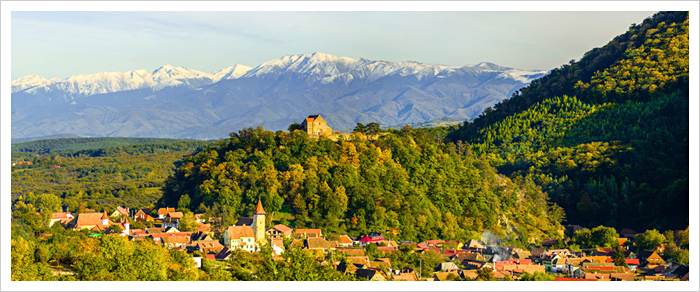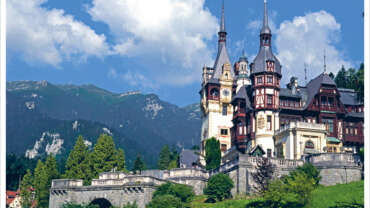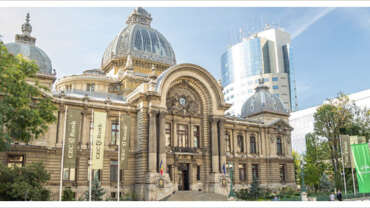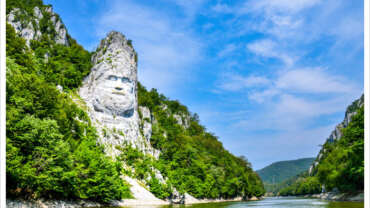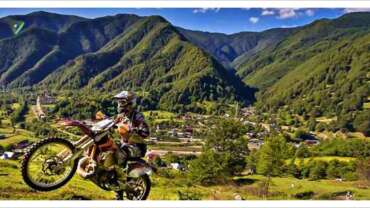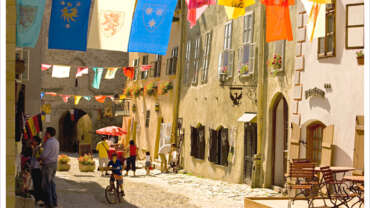Historical Regions of Romania
Transylvania
Transylvania is home to some of Europe’s best-preserved medieval towns, most notably Brasov, featuring Old Saxon architecture and citadel ruins; Sibiu with its cobblestone streets and pastel-colored houses, and Sighisoara, adorned with a hilltop citadel, secret passageways and a 14th century clock tower. Tiny shops offer antiques and fine hand-made products by local artisans and artists.
Visitors to Transylvania will also encounter stunning castles such Bran, near Brasov, – a Gothic fairy-tale structure, often associated with 15th century Walachian Prince Vlad Tepes, the inspiration for Bram Stoker’s Dracula. While the connection with Vlad is tenuous, the deep bond of local villagers with the legend is not.
In close proximity to Brasov and Bran are the fortified churches at Harman, with its massive 13th Saxon towers, and Prejmer, the largest fortified church in Southeastern Europe. The 15th-century Corvinilor Castle, the most beautiful in Transylvania, located nearby Hunedoara, has a sumptuous Knights Hall – that can be used for functions or parties, as well as towers and buttresses reminiscent of the medieval times.
Banat and Crisana
The unique mix of architectural and cultural heritages in the history-rich provinces of Crisana and Banat stems from the fact that for centuries Romanians have lived here alongside Germans (Swabs), Serbians and Hungarians (Magyars). A trio of western Romania cities – Timisoara, Oradea and Arad – provides travelers with an insight into this region’s long past and colorful traditions.
Habsburg rule until 1918 introduced Art Nouveau architecture in Banat and established Timisoara as “the garden city.” Frequently referred to as “Little Vienna,” Timisoara has always been a progressive, cosmopolitan city. An important trade and university town, Timisoara features open squares, parks and gardens, elegant boutiques, cafes, restaurants and a great display of Secessionist architecture. Cultural attractions include the Banat Museum (art, natural history and ethnography) the Village Museum, the Botanical Garden, the Timisoara Philharmonic and the Opera House. Places of historical note include the Ruins of Timisoara Fortress, Huniade Castle, Dicasterial Palace, Old City Hall and the Palace of Justice.
Just north of Timisoara on the Mures River banks lies the city of Arad, tracing its history back to the 12th century. Churches and cathedrals span four centuries, several denominations and architectural styles ranging from baroque to neoclassic. The exciting architecture of the buildings in the city’s square reflects the influence of the one-time Austrian-Hungarian occupation; most notable are the City Hall and Cenad Palace. An original Turkish fortress (built in 1550 and rebuilt twice in the 17th and 18th centuries), the Palace of Culture and the State Philharmonic House are some of the other sights to enjoy here.
Oradea, eight miles east of the Romanian-Hungarian border, is one of the most picturesque towns of western Romania, as well as an important cultural center. At the turn of the last century, most of the town’s old houses were rebuilt and customized to the then trendy architectural style from Vienna called “Sezession,” with its richly decorated facades of pale pink, green, blue and white. To get a feel for the city’s past, stroll around the Old Downtown and visit the Museum of the Cris Rivers, housed in a splendid 1770 baroque palace with 365 windows modeled after the Belvedere Palace in Vienna.
Western Romania is a heaven for active travelers and adventure seekers, with abundant opportunities for trekking, mountain climbing, hunting, fishing, horseback riding and more. Crisana and Banat have exquisite natural scenery with a climate similar to that of the Mediterranean region.
Baile Herculane, within driving distance of Timisoara, is an ancient Roman spa, developed in the 19th century as a fashionable resort. Legend has it that Hercules himself bathed in the strength-giving natural springs. Mount Domogled, to the west of the resort, is an extensive forest reservation sheltering rare trees, turtles and butterflies.
The Bihor Mountains, descending from east to west, hold some of the best-hidden treasures of Romania; explore the cave tunnels, underground waterfalls, hidden lakes, canyons and glaciers. West of the Bihor Mountains is Bears’ Cave. Named after fossil traces of the cave bear species (extinct 15,000 years ago) discovered here, it features two levels of galleries, extending more than a half-mile with stalactites and stalagmites estimated to be 22,000 years old, some resembling animal and castles shapes.
Bucovina and Moldova
Moldova rivals Transylvania when it comes to rich folklore, natural beauty and astonishing history. Over the past 500 years, history, culture and religious life have molded Iasi, the cultural capital of Moldova. Iasi boasts an impressive number of Orthodox churches, almost 100, most of them located in the Golden Plateau, representing the nucleus of the city, around which the city developed over the centuries. One of the most famous monuments in the city is the stunning Church of the Three Hierarchs, built in 1639. Another major landmark in Iasi is the neo-gothic Palace of Culture, built between 1900-1926, currently housing the Ethnographic Museum, the Art Museum, and the History Museum of Moldova.
Nestled in the rolling hills of northern Moldova is the region of Bucovina, home to one of the world’s greatest art treasures: the UNESCO World heritage sites of the Painted Monasteries of Bucovina. Built in the 15th and 16th centuries and featuring colorful exterior frescoes depicting dramatic religious scenes, these richly decorated houses of worships are unique in the world.
The most famous of these, often called “the Sistine Chapel of the East” is Voronet Monastery. Erected in 1438 by Stefan the Great, Voronet’s most stunning feature is a Last Judgment fresco painted – as at all the churches – on the exterior façade. The blue paint that has miraculously never faded is known throughout the world as ‘Voronet blue’. The artists here worked in isolation, guarding their trade secrets and to this day, the composition of the paint remains a mystery.
Other painted churches not to be missed include Sucevita, with its distinctive greens, and Humor, where the frescoes are predominantly red. Also nearby are, Arbore, Dragomirna, Moldovita and Putna monasteries.
The town of Suceava, may be the best starting point for a trip to the monasteries. Once the capital of Moldavia (from 1375 until 1565), it has some noteworthy attractions of its own, such as the remains of the Fortress of Suceava built in 1388. Today, visitors can tour the remains of the impressive fortifications and take in a great view of the city. Other sights in Suceava include the St. George Church (UNESCO World Heritage Site), Mirauti Church, the Zamca Monastery and a number of museums dedicated to woodcraft, ethnography, history and folk art. The Bucovina History Museum displays medieval armor, coins, tools and ancient documents. Its Hall of Throne is a re-creation of Stephen the Great’s court with furniture, weapons and costumes.
A visit to Bucovina would not be complete without some stunning nature walks through Ceahlau National Park, Romania’s Olympus – the sacred mountain of the Dacians, the forefathers of the Romanian people. Make sure you bring binoculars as some 90 species of birds can be seen in the park area. Hikers won’t want to pass up taking a crack at the Bicaz Gorges, a steep, twisting-and-turning climb more than three miles long.
Dobrogea
Dobrogea region is home to the Danube Delta, a 2,200-square-mile wildlife reserve designated by UNESCO as a “Reservation of the Biosphere;” the ancient port city of Constanta, and the seaside resorts stretching along Romania’s 152-mile Black Sea coast. From the port city of Tulcea, day cruises through the Delta’s waterways give travelers a glimpse of the abundant wildlife and the traditional fishing villages. Floating reed islands, sand dunes and waterways offer shelter to over 300 species of birds, countless fish and 1,150 species of plants.
South of the Delta, the historical city of Constanta serves as a major port on the Black Sea. Featuring several museums, historical monuments, fine mansions and a grand casino, the city is the focal point of Black Sea coast tourism. A strip of fine-sand beaches dotted with seaside resorts named after women and mythological gods, such as Eforie, Jupiter, Neptun, Olimp, Saturn, Venus and Mangalia, stretches from Constanta to the Bulgarian border.
Walachia
Wallachia’s unique mix of historical and natural attractions promises a different experience each day. Discover heritage buildings and museums in the capital city, enjoy day trips to a royal palace or century-old monastery, hike the mountains or follow Brancusi’s art trail – the choice is yours.
First documented in 1459 by Vlad Tepes, Bucharest is the main city of the region and the capital of Romania. Whether you are spending most of your travel time here or just using it as a gateway to a discovery journey around Romania, Bucharest and its cultural scene is going to surprise you: 37 museums, 22 theaters, 18 art galleries, opera houses and concert halls await your visit.
The best way to explore Bucharest is to take a stroll along Calea Victoriei to Piata Revolutiei, site of the Romanian Athenaeum and the former Royal Palace, now the National Museum of Art. The old city center (near Lispcani) is a must to understand why Bucharest was known as “Little Paris” in the 1920s. Also, don’t miss the Palace of Parliament, the second largest building in the world.
Beyond Bucharest, the foothills of Wallachia give way to the Carpathian Mountains. Just an hour and a half north of Bucharest is the beautiful Prahova Valley, where the popular ski resorts of Predeal, Busteni and Sinaia are located. Sinaia is also home to the magnificent Peles Castle – a masterpiece of German new-Renaissance architecture, considered one of the best-preserved royal castles in Europe. In the summer time, these resorts are starting points to hiking trails in the nearby Bucegi Nature Park.
A must stop for art lovers is the town of Targu Jiu on the banks of the Jiu River. This former market town is closely associated with Constantin Brancusi, the Romanian artist who is considered to be the founder of modern sculpture.
Some of Romania’s most tranquil monasteries can be found in this region, including Horezu, a masterpiece of the ‘Brancovenesti’ architectural style and a designated UNESCO World Heritage site. Horezu is also a renowned pottery center, where travelers can marvel at the colorful pottery created in local workshops by talented artisans.
Maramures
The northwestern Romanian region of Maramures is home to many villages where century-old traditions are still part of daily life. The inhabitants of this area have preserved, to an amazing extent, the rural culture and crafts of their Dacian ancestors.
Maramures villages are distinguished by their unique wooden churches with tall spires and shingled roofs. Woodlands still account for more than four-fifths of the land surface of Maramures. It is understandable, therefore, that wood has long been – and continues to be – the medium of expression for the region’s artisans. Elaborate woodcarvings decorate the eaves, entryways and windows of houses. The local handiwork is also seen in the hand-woven carpets and intricate embroidery that adorns folk dresses still worn by the locals.
Carved Wooden Gates
The local craftsmanship can be best observed in the monumental Maramures gates, guarding the entry to the houses. Supported by three columns, they feature traditional ornamental motifs, including the sun and the twisted rope – both symbols of life and continuity. Some of the most beautiful wooden gates are found in the villages of Vadu Izei, Desesti, Giulesti, Budesti, Sarbi, Barsana and Oncesti. The villages of Barsana and Oncesti have, perhaps, the greatest number of impressive gates.
Wooden Churches
As it has for hundreds of years, social life in Maramures continues to revolve around the village church.
The Wooden Churches of Maramures ) – in Surdesti, Plopis, Rogoz, Ieud, Poeinile Izei, Barsana, Budesti and Desesti – have been recognized by UNESCO as some of the most important sites of world heritage.
Unique in shape and ornamentation, they have characteristic high roofs and tall, narrow, pointed steeples, often collectively describer as ‘the Gothic style of Maramures.’
The primary wood material used by the artisans who built them was local oak, which has survived the elements with sturdy elegance until today. The interior walls of the churches were painted by local artists, with biblical scenes often juxtaposed against the familiar landscape of the village.
The spiritual philosophy of the people of Maramures is perhaps nowhere more apparent than in Sapanta. The town folks’ ancestors considered death as a beginning, not the end, and this faith is reflected in the carvings in the town’s unique Merry Cemetery . Blue wooden crosses feature a carved scene and humorous verses that endeavor to capture essential elements – both the good and the imperfections – of the deceased’s life. Even without benefit of translation, visitors can appreciate the handiwork of sculptor Stan Ion Patras, who began carving these epitaphs in 1935, and his successors. Patras’ house in the village is now a fascinating museum. Sapanta is also home to several wooden gates and one of the region’s tallest wooden churches.
Sapanta is a 20-minute drive, to the west, from Sighetu Marmatiei, an important tourist and cultural center in the region. The outdoor village museum in Sighetu Marmatiei boasts dozens of homes and farm buildings assembled from around Maramures County. Other attractions include the 16th century Reform Church, the Elie Wiesel Memorial House, and the Victims of Communism Memorial (Museum of Arrested Thought), located in a former communist prison in the center of town.
Maramures is dominated by a landscape of mountains and rolling valleys. The Gutai, Lapus, Tibles Maramures and Rodnei Mountains are cut by passes named Huta, Gutai, Prislop, Setref, and Botiza. Three large valleys cross the region: Viseu, Iza and Mara. The Rodnei Mountains National Park, a natural reserve filled with a rich diversity of flora and fauna, has been awarded biosphere status by UNESCO. Here, chamois leap between rocks, the cry of eagles’ rings out overhead and as the snows recede in the spring, crocus and other flowers create swathes of dazzling colors.



